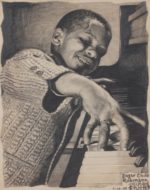Frank “Sugar Chile” Robinson is an American jazz pianist and singer. He became famous as a child prodigy in the mid–1940s, and this little genius gained top billing and performed at notable venues. He was the first African American performer at the White House Correspondent’s Dinner in 1946
Early Life
Frank Isaac Robinson was born in Detroit on December 28, 1938, and was the youngest of 7 children. He was known as Sugar Chile Robinson, and his mother called him “Sugar Chile.” His parents didn’t play any instruments, but they did have a piano that his aunt left at their house. According to legend, ‘Sugar Chile’ would climb onto the piano bench and teach himself to play what he heard on the radio. Little “Sugar Chile” would slap the piano with his elbows and fists.
His Big Break
He was disqualified from a talent competition for being too young. However, he won another talent contest for kids under 18 when he was three. Imagine everyone’s jaw-dropping when a young child sat at the piano and started to play and sing the blues.
Robinson stunned the crowd with his incredible piano, blues and jazz abilities when he won a talent competition at the age of three at Detroit’s very own Paradise Theatre; by 1945, he had been “discovered” by pianist and bandleader Frankie Carle.
Metro-Goldwyn-Mayer (MGM) offered Frank’s father a seven-year contract, but he turned it down. But later signed the movie contract. He rose to fame after appearing in the 1946 American film “No Leave, No Love.” He made a cross-country tour and broke box office records.
His Career
Sugar Chile started performing in large venues, breaking attendance records in Detroit and California. He received special permission to join the American Federation of Musicians in 1949, enabling him to record his first two Capitol Records singles, “Numbers Boogie” and “Caldonia,” which peaked on the Billboard R&B chart and became the organization’s youngest-ever member at the time.
Frank played ‘Caldonia’ for President Harry S. Truman at the White House. He famously shouted, “How’m I Doin’, Mr. President?” which became his catchphrase. Truman gave him a big thumb’s up.
He was the first black performer at the White House Correspondents’ Dinner.
Touring
He headlined for a week at Chicago’s Regal Theatre, making more than $36,000, a record that remains the biggest one-week attraction of the theatre’s history.
His last single was issued in August 1952, and shortly after that, a 10″ collection LP, boogie-woogie featuring many of his 1952 songs, was published. He performed at four engagements in 1953, then three more in 1954, one at The Blue Note in Chicago in August 1954 with jazz saxophonist Gerry Mulligan. He performed just twice between 1955 and 1956 under his current name, Frank Robinson, and at the ripe old age of eighteen, he gave up the stage.

By 1950, he was touring with Count Basie and appeared on television and in the short film Sugar Chile Robinson, Billie Holiday, Count Basie and His Sextet. During the 1950 holiday season in Europe, Sugar Chile’s “Christmas Boogie” c/w “Rudolph The Red-Nosed Reindeer” sold well enough to prompt a two-month tour of the UK in the summer of 1951. This included glowing reviews for his performance at the London Palladium, appearances on BBC TV, and a Melody Maker interview.
In 1952 he gave up music. He said, “I wanted to go to school… I wanted some school background in me, and I asked my Dad if I could stop, and I went to school because I honestly wanted my college diploma.”
Sugar Chile returned to school and finished high school at 15 years old. He graduated from Olivet College with a history degree and from the Detroit Institute of Technology with a psychology degree. He worked for his Uncle Frank’s chiropractor business after graduating.
After Music
Robinson worked for WGPR-TV in the 1960s and established a recording studio and tiny record labels in Detroit. He ran his own Lendo/Lando and Autocap labels in the 1960s while working for the family business. Rufus Wonder, Little Stevie’s cousin, and The Superlatives had minor hits on these labels. From 1962 to 1996, he worked part-time selling television commercials for the nearby broadcaster WGPR-TV.
“No one told me I was making history.”
Honors
Thanks to the American Music Research Foundation, Robinson has become a musician in recent years.
In 2002, he performed at a special concert honoring Detroit music. His 1950 “Go Boy Go!” recording was used in a Dockers television ad 2006.
Sugar Chile Robinson was the featured artist in the final Dr. Boogie show of 2013. He joined President Obama at the White House Correspondents’ Dinner on April 30, 2016, marking the 70th anniversary of his presence at the dinner in 1946. A standing ovation was given to him after the meal as a photo of him as a little child played on the TV screens. The same year, he was inducted into the Rhythm & Blues Hall of Fame.
Recent Years

Robinson temporarily reconnected with the music industry in the 1960s by co-owning the Detroit-based Lando and Lendo labels, which produced 45s by Rufus Wonder (Stevie Wonder’s cousin) and Carl Carlton. He obtained employment with the first African-American-owned television station, WGPR-TV selling TV advertising during this time. Frank established his recording studio and the AutoCap record label on the back of these modest triumphs, which also had a modest hit with “Don’t Walk Away” by The Superlatives.
He was in financial difficulty 2017, and a house fire destroyed his valuables. Robinson lived in a tiny flat with his niece without beds and a piano, so they slept on blow-up beds. After receiving a call from friends, the Music Maker Relief Foundation group sent him a bed and registered him for a monthly food program. Robinson received a piano from Buddy Smith, who he inspired in the 1940s.


